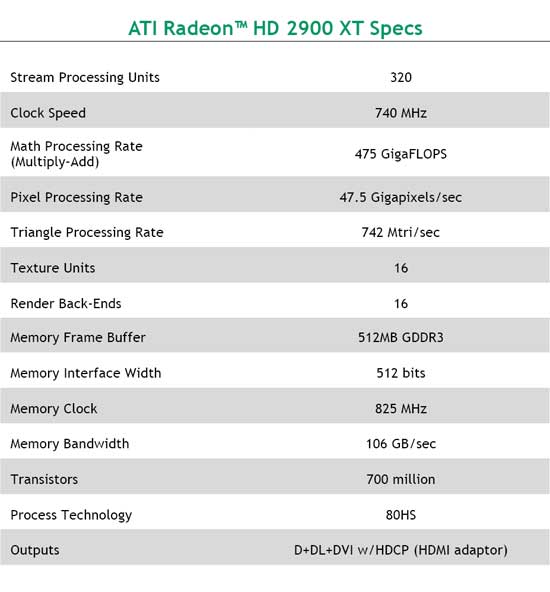ATI Radeon HD 2900 XT Video Card Review
X2000 Architecture
AMD has packed in tons of features for the HD 2000 Series of video cards, not the least is HDMI, HDCP, Physics calculations, and High Definition video acceleration but we would need at least 25 page article to fit it all in. Look for more on these features in future articles as we go in-depth to see just what you are getting in the most feature packed GPU to ever hit the market. For today, we are going to concentrate solely on gaming performance because since that is the primary focus of a video card.
Kicking things off, we would be incorrect in saying that this is the first Unified Shader Architecture by AMD. The fact is that the XBOX 360 GPU Xenos was their first. Building on the experience gained from Xenos, AMD has evolved their latest GPU to be a very serious beast when it comes to the calculations that DirectX 10 requires. The R600 uses 320 discrete, independent stream processing units compared to the 48 vector + 48 scalar units in the R580 series. This means that the R600 has full support for DirectX 10 and Shader Model 4.0. With DX 10 the shaders dynamically load balance between vertex, geometry, and pixel shader operations. This is accomplished by a dedicated hardware scheduler.
- 700 million transistors on 80nm HS fabrication process
- 512-bit 8-channel GDDR3/4 memory interface
- Ring Bus Memory Controller
- Fully distributed design with 1024-bit internal ring bus for memory reads and writes
- Optimized for high performance HDR (High Dynamic Range) rendering at
- Unified Superscalar Shader Architecture
- 320 stream processing units
- Dynamic load balancing and resource allocation for vertex,
- geometry, and pixel shaders
- Common instruction set and texture unit access supported for all types of shaders
- Dedicated branch execution units and texture address processors
- 128-bit floating point precision for all operations
- Command processor for reduced CPU overhead
- Shader instruction and constant caches
- Up to 80 texture fetches per clock cycle
- Up to 128 textures per pixel
- Fully associative multi-level texture cache design
- DXTC and 3Dc+ texture compression
- High resolution texture support (up to 8192 x 8192)
- Fully associative texture Z/stencil cache designs
- Double-sided hierarchical Z/stencil buffer
- Early Z test, Re-Z, Z Range optimization, and Fast Z Clear
- Lossless Z & stencil compression (up to 128:1)
- Lossless color compression (up to 8:1)
- 8 render targets (MRTs) with anti-aliasing support
- Physics processing support
- Full support for Microsoft DirectX 10.0
- Shader Model 4.0
- Geometry Shaders
- Stream Output
- Integer and Bitwise Operations
- Alpha to Coverage
- Constant Buffers
- State Objects
- Texture Arrays
- Dynamic Geometry Acceleration
- High performance vertex cache
high display resolutions


Comments are closed.